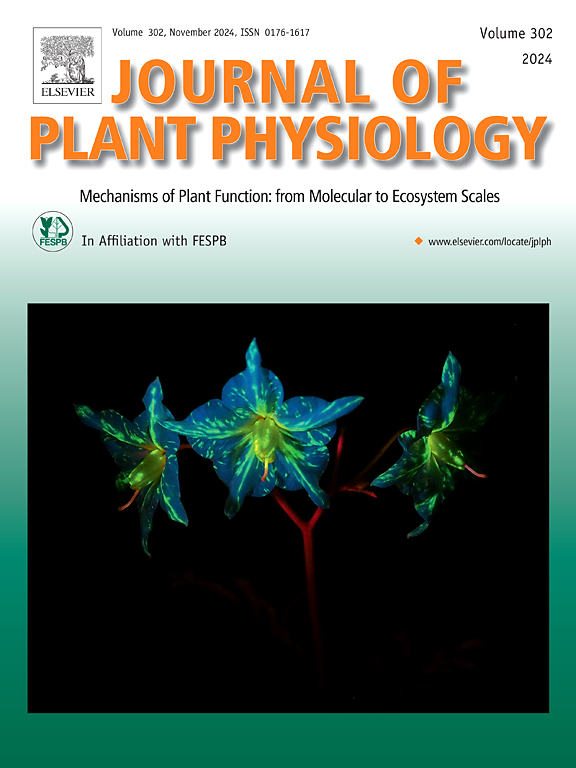腺苷驱动的平衡的核糖和脱氧核糖核苷酸是镁控制:定量的Mg2+信号。
IF 4
3区 生物学
Q1 PLANT SCIENCES
引用次数: 0
摘要
核苷单磷酸、二磷酸和三磷酸(NMP、NDP和NTP)及其脱氧对应物(dNMP、dNDP、dNTP)参与能量代谢,分别是RNA和DNA的组成部分。NTP和dNTP是由几种NMP激酶(NMPK)和NDP激酶(NDPK)产生的。所有的nmpk都是完全可逆的,并且在反应的两个方向上都使用确定的无mg和mg络合的核苷酸,Mg2+控制无mg和mg络合反应物的比例。它们的活性由腺苷酸激酶产生的腺苷酸驱动,腺苷酸激酶根据细胞的能量状态控制NMPK和NDPK反应的方向。这种酶机制定位于细胞质、线粒体和质体,即具有高能量预算的室室,在那里(细胞质除外)发生RNA和DNA合成。基于总核苷酸含量的nmpk的表观平衡常数依赖于[Mg2+]。这允许对内部[Mg2+]进行间接估计,这构成了给定组织/细胞/室的能量状态的信号。腺苷酸对Mg2+信号的贡献最大,其次是尿苷酸、鸟苷酸和胞苷酸,脱氧核苷酸的贡献可以忽略不计。讨论了一种利用核苷酸数据集定量Mg2+信号的方法。本文章由计算机程序翻译,如有差异,请以英文原文为准。
Adenylate-driven equilibration of both ribo- and deoxyribonucleotides is under magnesium control: Quantification of the Mg2+-signal
Nucleoside mono-, di- and triphosphates (NMP, NDP, and NTP) and their deoxy-counterparts (dNMP, dNDP, dNTP) are involved in energy metabolism and are the building blocks of RNA and DNA, respectively. The production of NTP and dNTP is carried out by several NMP kinases (NMPK) and NDP kinases (NDPK). All NMPKs are fully reversible and use defined Mg-free and Mg-complexed nucleotides in both directions of their reactions, with Mg2+ controlling the ratios of Mg-free and Mg-complexed reactants. Their activities are driven by adenylates produced by adenylate kinase which controls the direction of NMPK and NDPK reactions, depending on the energy status of a cell. This enzymatic machinery is localized in the cytosol, mitochondria, and plastids, i.e. compartments with high energy budgets and where (except for cytosol) RNA and DNA synthesis occur. Apparent equilibrium constants of NMPKs, based on total nucleotide contents, are [Mg2+]-dependent. This allows for an indirect estimation of internal [Mg2+], which constitutes a signal of the energetic status of a given tissue/cell/compartment. Adenylates contribute the most to this Mg2+-signal, followed by uridylates, guanylates, and cytidylates, with deoxynucleotides’ contribution deemed negligible. A method to quantify the Mg2+-signal, using nucleotide datasets, is discussed.
求助全文
通过发布文献求助,成功后即可免费获取论文全文。
去求助
来源期刊

Journal of plant physiology
生物-植物科学
CiteScore
7.20
自引率
4.70%
发文量
196
审稿时长
32 days
期刊介绍:
The Journal of Plant Physiology is a broad-spectrum journal that welcomes high-quality submissions in all major areas of plant physiology, including plant biochemistry, functional biotechnology, computational and synthetic plant biology, growth and development, photosynthesis and respiration, transport and translocation, plant-microbe interactions, biotic and abiotic stress. Studies are welcome at all levels of integration ranging from molecules and cells to organisms and their environments and are expected to use state-of-the-art methodologies. Pure gene expression studies are not within the focus of our journal. To be considered for publication, papers must significantly contribute to the mechanistic understanding of physiological processes, and not be merely descriptive, or confirmatory of previous results. We encourage the submission of papers that explore the physiology of non-model as well as accepted model species and those that bridge basic and applied research. For instance, studies on agricultural plants that show new physiological mechanisms to improve agricultural efficiency are welcome. Studies performed under uncontrolled situations (e.g. field conditions) not providing mechanistic insight will not be considered for publication.
The Journal of Plant Physiology publishes several types of articles: Original Research Articles, Reviews, Perspectives Articles, and Short Communications. Reviews and Perspectives will be solicited by the Editors; unsolicited reviews are also welcome but only from authors with a strong track record in the field of the review. Original research papers comprise the majority of published contributions.
 求助内容:
求助内容: 应助结果提醒方式:
应助结果提醒方式:


